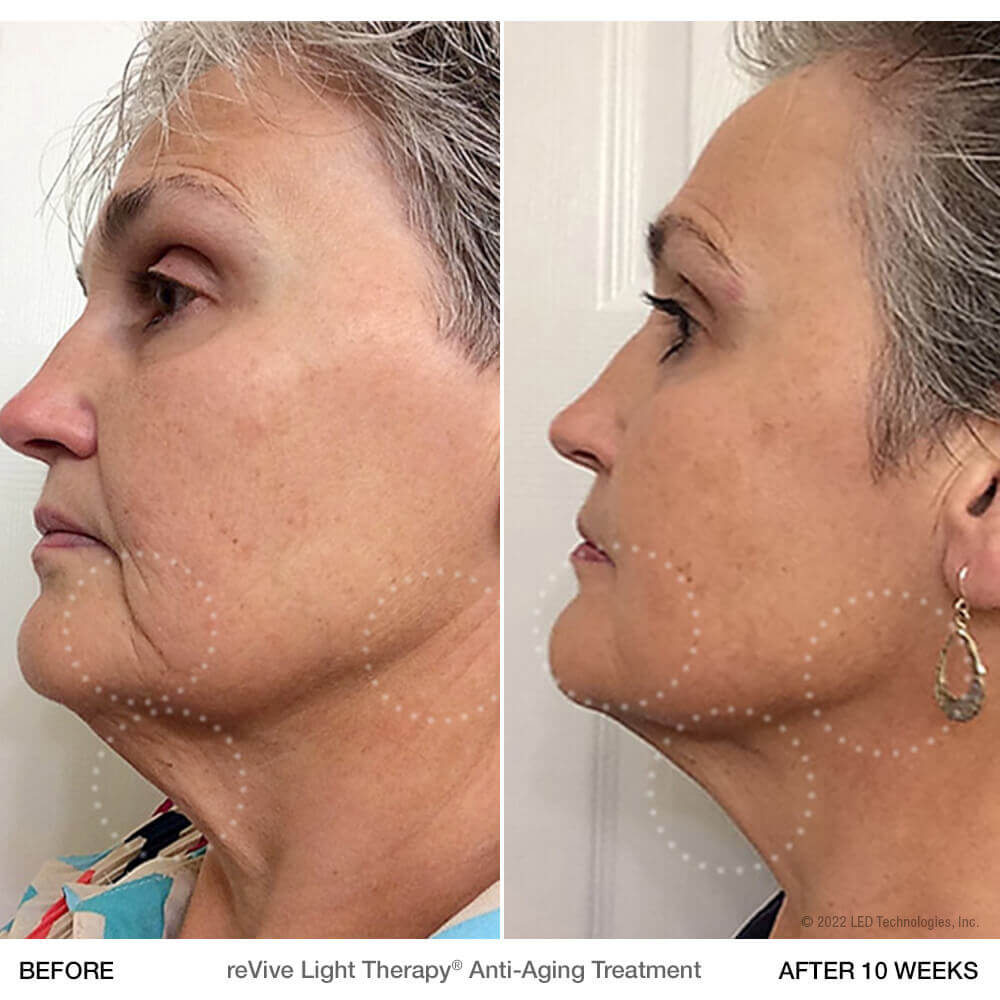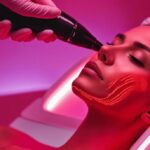As we age, we all want to find ways to slow down the process. Red light therapy is a relatively new technology that has been gaining attention as a promising solution to the signs of aging and other skin problems. In this article, we will explore the evidence to answer the question, can red light therapy slow aging? We will look at the research and potential risks, as well as discuss the benefits of this treatment as an anti-aging tool.

Contents
Can Red Light Therapy Slow Aging?
What is Red Light Therapy?
Red light therapy is a type of light therapy that utilizes low-level, red visible light wavelengths between 630-700nm to promote cell regeneration, collagen production, and reduce inflammation. Red light therapy is used for a number of cosmetic and medical purposes such as skin rejuvenation, anti-aging, wound healing, and pain management. This type of therapy is also known as photobiomodulation, low-level light therapy, or LED light therapy.
The red light is delivered directly to the skin or tissue in order to stimulate the body’s natural healing process. This process is believed to be caused by the red light’s ability to penetrate into the skin’s deeper layers and directly interact with the cells.
How Does Red Light Therapy Work?
Red light therapy works by stimulating the production of ATP (Adenosine Triphosphate) within the cells. ATP is a molecule that is responsible for providing energy for the cells to carry out their daily functions. By stimulating the production of ATP within the cells, red light therapy can help the cells to carry out their daily functions more efficiently. This can lead to a number of beneficial effects such as increased cell regeneration, improved circulation, and increased collagen production.
Red light therapy is also believed to reduce inflammation and pain by stimulating the release of endorphins, the body’s natural painkillers. Endorphins help to reduce pain and inflammation, leading to improved overall health and well-being.
Can Red Light Therapy Slow Aging?
Red light therapy has been shown to be effective in reducing the signs of aging and promoting a more youthful appearance. This is due to the fact that red light therapy can help to stimulate the production of collagen, which is a protein that aids in the skin’s elasticity and firmness. By increasing collagen production, red light therapy can help to reduce wrinkles and improve the overall appearance of the skin.
Red light therapy can also help to reduce the appearance of age spots and sun damage, as well as reduce the appearance of fine lines and wrinkles. By stimulating the production of ATP, red light therapy can also help to improve the skin’s overall texture and tone.
Is Red Light Therapy Safe?
Red light therapy is generally considered to be a safe and non-invasive treatment option. Unlike other types of light therapy, red light therapy does not emit any UV radiation and is not known to cause any adverse side effects.
However, it is important to note that red light therapy should not be used in place of conventional medical treatments. If you have any concerns about red light therapy, it is always best to consult with a medical professional before undergoing any type of treatment.
Summary
Red light therapy is a non-invasive treatment option that can be used to reduce the signs of aging and promote a more youthful appearance. Red light therapy works by stimulating the production of ATP, which helps to improve cell regeneration, collagen production, and reduce inflammation. Red light therapy is generally considered to be a safe and effective treatment option and has been shown to reduce the appearance of wrinkles, fine lines, and age spots. However, it is important to consult with a medical professional before undergoing any type of treatment.
Top 6 Frequently Asked Questions
Q1. What is red light therapy?
Answer: Red light therapy is a type of phototherapy that uses low-energy infrared light to stimulate the body’s natural healing processes. This type of light therapy is used to treat a variety of skin conditions, including wrinkles, acne, rosacea, and other signs of skin aging. Red light therapy has been found to be effective in treating sun damage and promoting collagen production, which can help reduce the appearance of fine lines and wrinkles. Additionally, red light therapy has been used to help reduce inflammation, stimulate blood circulation, and reduce pain.
Q2. How does red light therapy work?
Answer: Red light therapy works by stimulating the body’s cells with a particular type of light called near-infrared light. This type of light is thought to stimulate the body’s natural healing processes and promote cellular regeneration. When the cells are exposed to this type of light, it triggers a process called photobiomodulation, which helps to increase the production of collagen and elastin, both of which are important for healthy skin. Additionally, red light therapy is thought to stimulate the production of ATP, which is a type of energy that helps to repair and regenerate cells.
Q3. What are the benefits of red light therapy?
Answer: Red light therapy has many benefits, including reducing wrinkles, promoting collagen production, reducing inflammation, stimulating blood circulation, reducing pain, and improving the appearance of sun-damaged skin. Additionally, red light therapy has been found to be effective in treating a variety of skin conditions, including acne, rosacea, and other signs of skin aging. Red light therapy has also been found to be helpful in treating a variety of other conditions, such as joint pain, fibromyalgia, and psoriasis.
Q4. Does red light therapy slow aging?
Answer: Red light therapy has been found to be effective in reducing the appearance of wrinkles and other signs of skin aging. Red light therapy works by stimulating the body’s natural healing processes, which can help to promote collagen production and reduce the appearance of fine lines and wrinkles. Additionally, red light therapy is thought to help reduce inflammation, which can help to reduce the appearance of wrinkles and other signs of aging. While red light therapy may help to slow the aging process, it is not a miracle cure and should be used in conjunction with other anti-aging treatments.
Q5. Is red light therapy safe?
Answer: Red light therapy is generally safe and has few risks, though it is important to follow the instructions of a qualified healthcare professional when receiving treatment. Red light therapy has been found to be safe for most people, though those with certain medical conditions, such as lupus, should consult with their doctor before undergoing treatment. Additionally, it is important to use a reputable red light therapy provider, as the improper use of red light therapy can increase the risk of side effects.
Q6. How often should I receive red light therapy?
Answer: The frequency of red light therapy treatments depends on the individual, their goals, and the condition being treated. Generally, red light therapy treatments are recommended to be performed 2-3 times per week for 4-6 weeks. After the initial treatment period, most people find that maintenance treatments a few times a month can help to maintain the benefits of red light therapy. It is important to follow the instructions of a qualified healthcare professional when receiving red light therapy treatments.
ANTI-AGING SKIN BENEFITS OF RED LIGHT LED THERAPY| DR DRAY
In conclusion, Red Light Therapy can be a safe and natural way to slow the aging process. While there is no definitive proof that it can completely stop aging, numerous studies have shown that it can help reduce wrinkles, age spots, and improve skin tone and texture. While more research is needed, the evidence to date suggests that red light therapy can help slow the aging process and improve the overall health of the skin.


.jpg)





